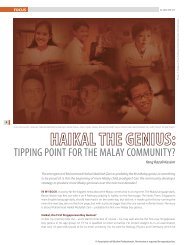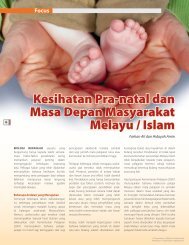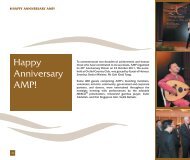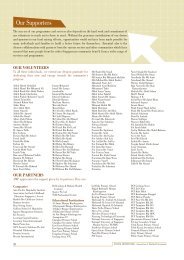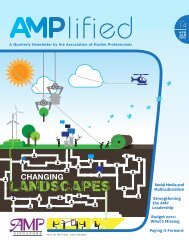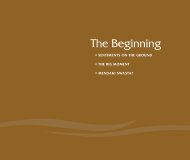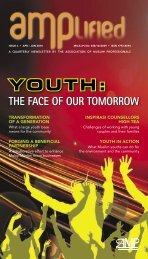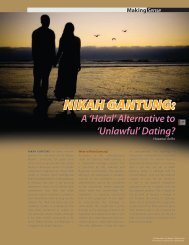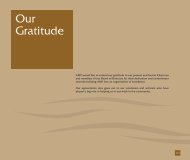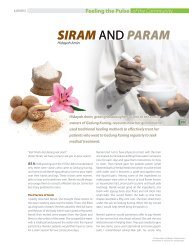community - Association of Muslim Professionals
community - Association of Muslim Professionals
community - Association of Muslim Professionals
Create successful ePaper yourself
Turn your PDF publications into a flip-book with our unique Google optimized e-Paper software.
KARYAWAN<br />
COMMUNITY<br />
IN REVIEW<br />
CHART B: Percentage <strong>of</strong> P1 Cohort Admitted to Post-Secondary Institutions<br />
Source: Ministry <strong>of</strong> Education Press Release (2009). “Performance by Ethnic Group 1999-2008”.<br />
<br />
In August 2009, Dr Yaacob expressed concern about high dropout rates among Malay ITE students and<br />
described it as having reached “worrying levels”. However, in October, Mr Masagos Zulkifli Masagos Mohamad,<br />
Senior Parliamentary Secretary for Education and Home Affairs, said that the attrition rate among students <strong>of</strong> all<br />
ethnicities has declined since several years ago. About 82% <strong>of</strong> the 2006 cohort completed their course with full<br />
certificates while two-thirds <strong>of</strong> the remaining obtained certificates for finishing at least one module.<br />
9<br />
The performance <strong>of</strong> Malay students in ITE is especially important because, being the largest in number among<br />
Malay post-secondary students, they will be instrumental in influencing the occupational pr<strong>of</strong>ile <strong>of</strong> the Malays<br />
in the workforce in the immediate future. The educational attainment <strong>of</strong> Malay workers has not kept up with<br />
that <strong>of</strong> the resident workforce, as comparing Charts C and D show, leaving a high proportion <strong>of</strong> Malays in lowerskilled<br />
occupational categories. Figures from the Ministry <strong>of</strong> Manpower (MOM) show that PMETs (Pr<strong>of</strong>essionals,<br />
Managers, Executives and Technicians) formed 51% <strong>of</strong> the workforce in 2008 (Chart E). In contrast, only 21.2%<br />
CHART C: Educational Attainment <strong>of</strong> Resident Labour Force, 1998 and 2008 (As at June)<br />
14.0%<br />
25.8%<br />
10.6%<br />
9.9%<br />
12.3%<br />
CHART D: Educational Pr<strong>of</strong>ile <strong>of</strong> Resident Working Malays Aged 15 Years & Over<br />
1.8%<br />
3.1%<br />
9.8%<br />
3.0%<br />
4.3%<br />
17.7%<br />
5.1%<br />
7.6%<br />
21.5%<br />
29.2%<br />
14.2%<br />
23.5%<br />
52.4%<br />
53.3%<br />
48.5%<br />
36.2%<br />
24.2%<br />
33.0%<br />
21.7%<br />
17.3%<br />
1998 2008<br />
■ Below Secondary ■ Secondary ■ Upper Secondary ■ Polytechnic ■ Degree<br />
Source: Manpower Research and Statistics Department, Ministry <strong>of</strong> Manpower<br />
1995 2000 2005<br />
■ Below Secondary ■ Secondary ■ Upper Secondary ■ Polytechnic ■ Degree<br />
Source: General Household Survey 2005, Census <strong>of</strong> Population 2000<br />
© <strong>Association</strong> <strong>of</strong> <strong>Muslim</strong> Pr<strong>of</strong>essionals. Permission is required for reproduction.



